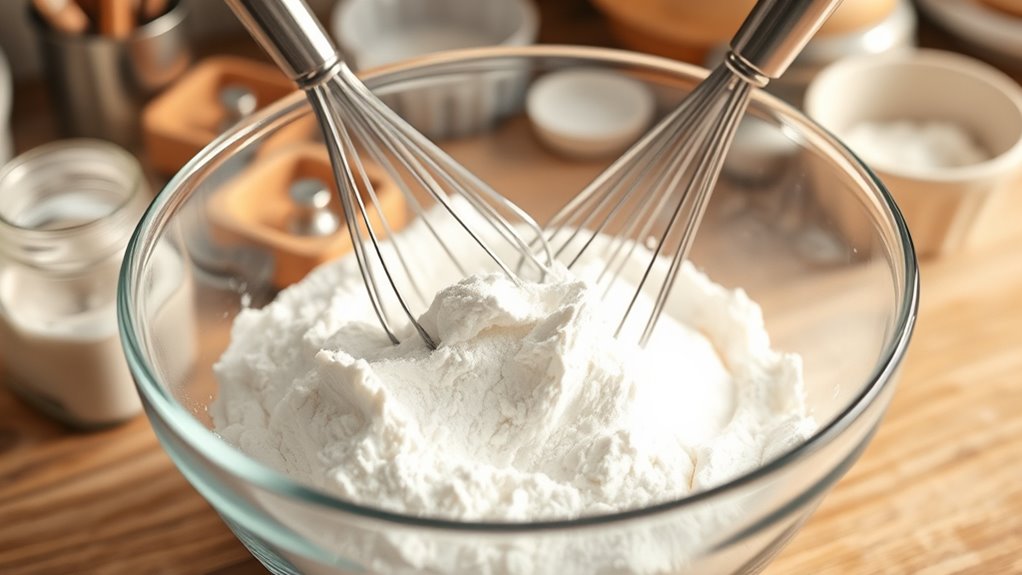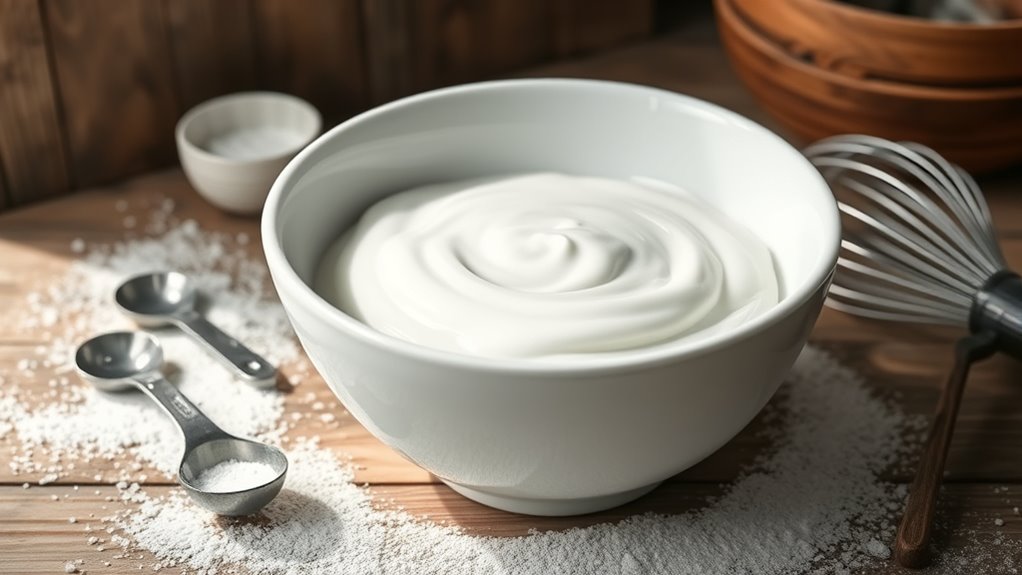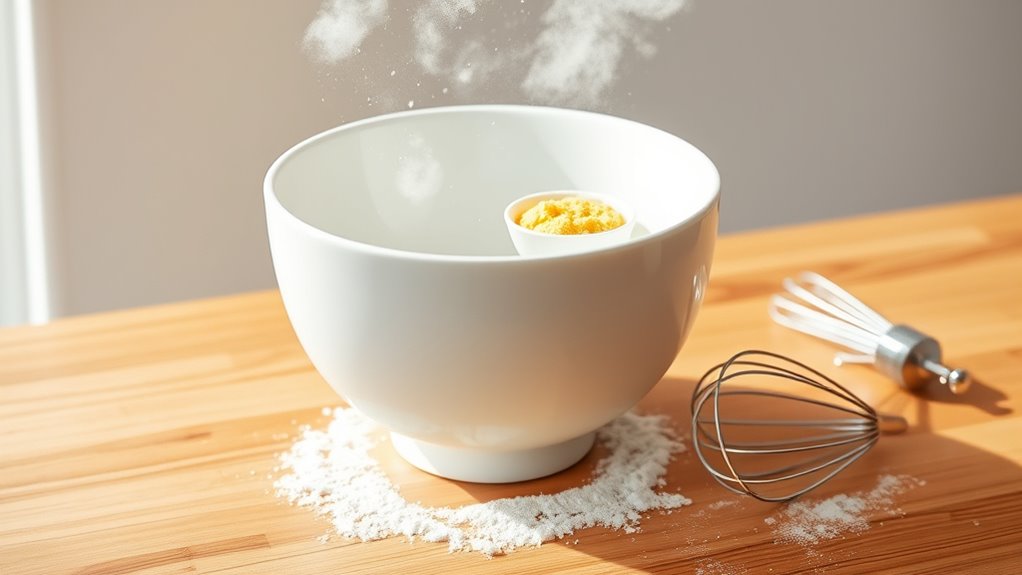To make a smooth, glossy royal icing with cream of tartar, start by whisking 4 cups powdered sugar with 2 tablespoons meringue powder until combined. Gradually beat in 1/4 cup water or lemon juice, then raise the speed to achieve a glossy, stiff yet workable consistency. Add a 1/4 teaspoon cream of tartar and optional 1/2 teaspoon flavor, adjusting with tiny amounts of liquid as needed. Let the mixture rest briefly, then pipe or drizzle; more tricks await.
Ingredients and Quantity

For royal icing, you’ll need powdered sugar, meringue powder or egg whites, and a bit of water or lemon juice. You’ll measure precisely, then fold in cream of tartar to stabilize. If you prefer texture control, note how icing consistency shifts with liquid adjustments. You’ll keep flavors clean at first, reserving flavor variations for later tests.
| Ingredient | Quantity |
|---|---|
| Powdered sugar | 4 cups |
| Meringue powder or egg whites | 2 tablespoons / 2 large whites |
| Water or lemon juice | 1/4 cup, plus as needed |
| Cream of tartar | 1/4 teaspoon |
| Optional flavor extract | 1/2 teaspoon |
You’ll aim for a smooth, glossy finish, ready to pipe, flood, or decorate with confidence and freedom. Royal icing, cream of tartar, icing consistency, flavor variations.
Preparations

Start by setting up a clean workspace and gathering all ingredients and tools. You’ll prepare with focus, keeping everything organized for smooth execution.
- Prepare tools: mixer, piping bags, tips, spatula, and measurement spoons, ensuring clean, dry surfaces.
- Prepare bowls: one for icing, one for color if needed, and one for icing consistency checks.
- Prepare timing: set a timer for mixing stages and resting periods to maintain consistency.
- Prepare technique: calibrate speed, pulse, and scraping rhythms to avoid air pockets and overworking, maintaining a glossy, smooth finish.
Preparation techniques and preparation tools guide you to a stable base, accurate hydration, and controlled texture, so your royal icing remains workable for detailed decorating without sacrificing flavor or stability.
How to Cook

- Whisk together powdered sugar and meringue powder until evenly combined.
- Gradually beat in water or egg white until the mixture is smooth and free of lumps.
- Adjust speed to maintain control, as icing consistency depends on gradual hydration.
- Beat until the mixture is glossy.
- Pause to scrape the bowl, ensuring no pockets of dry sugar remain.
- If the icing is too stiff, add tiny amounts of water.
- If the icing is too thin, add a bit more powdered sugar.
- For decorating, transfer the icing to a piping bag or drizzle with a steady hand.
- Maintain a steady tempo, allowing air to escape as you work.
- Let the icing rest briefly to set.
- Observe that a balanced, smooth glaze results in crisp outlines and clean edges.
How to Serve

If you’re serving royal icing, pair it with cookies that have a firm, level base and minimal moisture to prevent sogginess. You’ll aim for clean cuts and stable surfaces that showcase your icing work.
1) Serving suggestions: present on a neutral platter, with small palette knives for neat application, and offer a few color accents that enhance contrast.
2) Presentation ideas: use varied shapes, staggered heights, and a light dusting of edible shimmer to catch the eye without overwhelming the design.
3) Portioning tips: slice cookies evenly and arrange in a grid or fan pattern for visual balance.
4) Color coordination: coordinate icing tones with the plate color and table décor for cohesive display.
Tips

When you’re building a stable iced surface, keep your royal icing at the right consistency and air it out before you start decorating. In this Tips section, you’ll tune texture with small adjustments rather than large swings, ensuring predictable flow. Begin by evaluating stiffness: you want enough body to hold edges, but not so thick it muddies details. If necessary, thin with tiny amounts of water or corn syrup, then rebeat until smooth. Maintain smooth, glossy surfaces by avoiding air pockets; gently fold or beat to release them. For icing techniques, work in controlled dashes rather than long, frantic pipes. For decorating tips, plan layers and outlines first, letting each set slightly before adding shadows or highlights. Precision, pace, and practice will sharpen your results.
Food Value and Benefit
Royal icing is a sweet glaze made primarily from egg whites (or meringue powder) and powdered sugar, commonly used for decorating baked goods. While it is not a significant source of vitamins and minerals, it offers certain food values and benefits:
Food Value:
- Provides carbohydrates mainly from powdered sugar, serving as a quick energy source.
- Contains small amounts of protein from egg whites.
- Supplies trace minerals such as selenium and potassium from egg whites.
Benefits of Eating Royal Icing:
- Quick energy boost due to its high sugar content.
- Contains protein and essential minerals like selenium, which supports antioxidant functions.
- Firm texture helps maintain the shape of decorations, enhancing the visual appeal of desserts.
- Versatile for use with edible colorants, allowing creative and attractive presentations.
Vitamins and Minerals:
- Selenium: supports immune function and antioxidant protection.
- Potassium: aids in maintaining fluid balance and muscle function.
- Small amounts of B vitamins from egg whites.
Note: Due to its high sugar content, royal icing should be consumed in moderation. Those concerned about raw egg consumption can use meringue powder as a safer alternative.
Frequently Asked Questions
Can I Substitute Cream of Tartar With Lemon Juice in Royal Icing?
Yes, you can substitute, but lemon juice isn’t as stable. Use about 1/8 teaspoon lemon juice per cup of sugar or powdered sugar, and expect a softer set. cream of tartar alternatives, lemon juice effectiveness vary.
How Long Does Royal Icing With Cream of Tartar Last?
You’ll get about 1–2 weeks refrigerated, or 1 week at room temperature if tightly covered. For best storage tips, keep icing airtight and free of moisture; consistency may harden slightly, so whisk lightly before use to restore ideal icing consistency.
Does Cream of Tartar Affect Icing Hardness or Gloss?
Did you know sugar crystals fascinate 97% of bakers? Cream of tartar slightly affects icing texture and meringue stability, helping you achieve a firmer gloss while keeping sugars smooth, precise, and forgiving for freedom-loving decorators.
Can I Dye Royal Icing With Natural Food Colorings?
Yes, you can dye royal icing with natural colorants. Start with a small amount, test for strength, and adjust gradually. Watch icing consistency, since natural dyes can thicken; mix thoroughly and note color payoff as you proceed.
Is There a Dairy-Free Version of This Recipe?
Dairy-free alternatives exist, yes; you can make vegan royal by swapping in plant-based meringue powder or aquafaba, plus dairy-free buttercream. You’ll whisk, stabilize, and set confidently, tasting as you go toward a liberated, precise finish.
